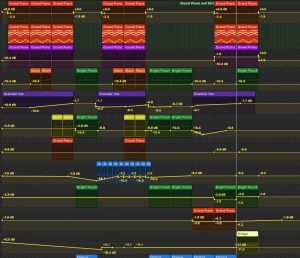Before recording vocals for this project I researched what other producers had to say about vocal mic choice. My research led me to a choice of 3 mics the RE20, the Neumann U87 and AKG C414. This gave me a range of sound and also a split between dynamic and condenser microphones. After reading the Sound on Sound tips on vocal mic production I definitely agreed with what they said. However I did like the contrast between songs and would select a different mic for a different section if I was redoing it.
“Electro-Voice RE20: The RE20 produced a sound with really nice lows and plenty of body. However, it sounded a bit ‘honky’ and ‘shouty’ on the more ‘pushed’ notes of the performance.
Neumann U47: As expected, the U47 resulted in a big, ‘brown’ and forward sound. It felt nicely balanced, but was still a little shouty. At lower levels it was better‑balanced, but there was still something of a ‘honky’ resonance.”
Although the U47 is not the same mic as the U87,
“A lead vocal will ideally be delivered as expressively and freely as possible, while respecting the melody, but this isn’t usually the case for BVs.” Before recording BVs I would map out the lead vocal on the track and Melodyne it so I had a clear sense of where the melody was going. This would allow me to push backing vocals in where needed and make sure they are 100% in tune with the lead vocal.
“Because double-tracking enhances tonality while blurring the rough edges of a less-than-perfect performance, it’s often a useful technique to deploy on mediocre or unconfident singers as a flattering effect. The (big) down side is that it can also reduce the immediacy and intimacy of a vocal part, especially if it’s a good one, so tread with care. Creating a double-track is easily accomplished by getting the singer to accompany their own lead vocal, duplicating any nuances wherever possible. Often, though, the process can be even simpler: if more than one take of the lead vocal has been recorded, with a little luck and a bit of editing an unused take can function as the double. But if the vocal is up-front and exposed, or if the main part features a once-in-a-lifetime performance, additional takes to duplicate it and/or some serious editing will be required.” A lot of my vocals are single tracked with a double track on the chorus because of this. I attempted double tracking everything, however it was a bit of overkill on the tracks and did reduce the immediacy and intimacy of a vocal part. So instead I decided to work more with the reverbs and delays to achieve a bigger vocal sound that sat within the track in a more comfortable sense.
“Additionally, consider the sheer amount of tracking that’s necessary to achieve the wide stereo spread typical of modern pop vocals. Two similar vocal tracks placed in the same location in the stereo field will clearly exhibit the effects of double-tracking, but once panned hard left and hard right, you’ll lose much, if not all, of that effect: each is now a single voice coming from a single speaker. In other words, in order to create a truly wide multi-tracked vocal, each part needs to be performed at least four times — twice each for left and right. (And having done that, you may well find that three or four times is better!)” Throughout this project I have been very aware of the vocal and trying to place vocals in where its needed, after reading this article I have employed this into one of my tracks in areas where I want the vocal to pop out more. (The first verse of I Am Lorde LaLaLa (Changing My Direction))
http://www.soundonsound.com/techniques/vocal-mics
http://www.soundonsound.com/techniques/crafting-perfect-pop-backing-vocals

